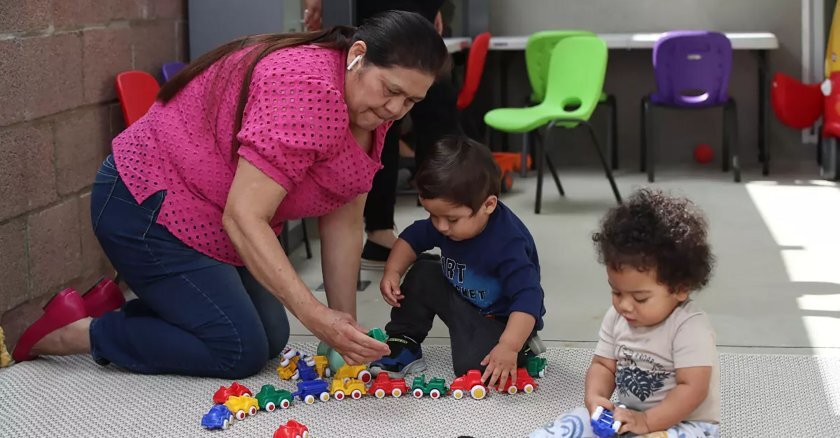In Brief:
- Parents across the country are struggling to both find and afford child care. At the same time, child-care providers operate on thin margins and struggle to pay workers enough to keep them.
- Lack of affordable, available child care isn’t just hurting parents — it’s also hurting state economies. Lawmakers say solving child-care access could keep more people in the workforce, enable companies to better recruit and keep employees they need, and entice more businesses into their states.
- States want to help. They’re trying strategies that range from offering tax credits for private donations to child-care centers to easing some regulations on child-care providers to incentivizing businesses to support child care for their employees.
“I would not have been able to work if the YMCA had not been available to provide afterschool care for my children,” recalls Missouri state Rep. Brenda Shields. Before joining government, she worked as a logistics specialist. But while her day ended at 5 p.m., her children left elementary school at 3 p.m.
She was facing a bind common to parents across the U.S. While Shields was able to find a local organization to help, families are often hunting for affordable and accessible care for their children.
But the steep cost of child-care tuition is often a drain on family budgets, and child-care centers themselves operate on slim margins. Many areas still lack enough child-care spots, despite the high demand.
But states aren’t leaving families and child-care centers to navigate this alone. Several are taking a look at how tax incentives, grants and regulatory changes could help increase the supply and lower the costs of child care.
For states, lack of sufficient child care is not just a family issue. It’s an economic problem, and a societal one.
“If we can figure out child care, we will be able to attract more businesses,” Shields says. “Businesses are telling us that 50 percent of the time they're having trouble either recruiting or retaining employees because of child care.”
A study released by the Missouri Chamber of Commerce and Industry estimated the state economy misses out on $1.35 billion a year in growth because companies cannot hire enough, in major part due to lack of child care.
In Indiana, the costs are higher still. The state loses out on an estimated $1.2 billion of tax revenue, while companies lose out on $3 billion, says Republican state Sen. Ed Charbonneau. That’s because unmet child-care needs cause employees to be absent or quit the workforce entirely. The Indiana Chamber of Commerce found that 57 percent of parents of young children had missed work or class at least once in the previous three months due to a child-care-related issue.
“Child care has risen to a level where [for] many, many, many companies, that's one of the issues they bring up when they're looking at locating a business in Indiana,” Charbonneau says.
High Tuition, Low Wages
Child-care tuition is steep. In much of the U.S. in 2023, the average annual cost of placing two kids in child care exceeded the average annual rent or mortgage payment, according to Child Care Aware of America, a child-care program resource and advocacy group.
Costs are high in part because child-care centers need a high staff-to-child ratio when working with young kids. But parents of young children are typically early in their careers, and so are facing these big expenses at a moment when their salaries haven’t had as much time to grow.
To prevent child-care tuition costs rising out of reach of more families, the centers pay their staff relatively low wages — which causes its own problems, leading to burnout and high turnover.
“A child-care worker isn't going to make all that much money,” Charbonneau says. “So, with the labor market the way it is, they're more than likely going to be finding a job someplace else. … The average early childhood teacher earns less than two-thirds of a kindergarten teacher’s salary, although 90 percent of their skills overlap.”
Challenges like these may be why, in many locations, there are not enough child-care offerings to meet demand.
Roughly 68 percent of Missouri counties have just one available child-care slot for every five eligible children, Shields says. “Anecdotally, what they will say is, if you haven’t put your name on a list before you even become pregnant, you will not be able to find a slot, especially for infant care, in our state.”
The pandemic made the situation worse, Shields notes. More parents started working from home and felt it was safest to keep their kids home, too. As a result, many child-care centers closed, and not all came back — in part because laid off staff had found better paying, less stressful jobs in other fields.
States Get Busy
In Missouri, Shields, a Republican, has been trying to pass three tax credits. One is a tax credit for individuals or organizations who donate money to existing child-care centers, and another is for child-care centers themselves — to help them defray the expenses of construction projects. The third tax credit would encourage companies to either create child-care programs for their employees or pay for slots at an existing provider.
Encouraging businesses to help their employees get child care is a popular idea, with 26 states reportedly offering some form of tax incentive or credit to companies that do this. The same number of states have, also or separately, offered tax reductions to families for some of the money they spent on child care. But Shields doesn’t see this latter option as practical for Missouri: “As a state, the amount that we could give individual parents would be a drop in the bucket to what we can do when we partner with businesses to make it happen,” she says. The Missouri law would ensure companies are serious about child care, because they have to spend the money first, before getting partial compensation.
This is Shields’ fourth year trying to get her tax credits proposal passed in Missouri. Despite support from Republican former Gov. Mike Parsons (who stepped down in January), earlier efforts were frustrated by conservative members in the Senate who argued government shouldn’t get involved in child care and worried that providing child-care supports would discourage people from becoming stay-at-home parents. But some Senate detractors are no longer in office.
Either way, Shields says she’ll keep pushing for change: “I've carried pieces of legislation that have taken me 4 or 5 years to pass. … We'll eventually find the sweet spot in which we can pass this piece of legislation.”
Other state approaches include providing direct funding to child-care centers or workers. Massachusetts, for one, has been offering grants to child-care centers to ease some operating costs. Meanwhile, Iowa Gov. Kim Reynolds recently expanded a pilot program providing financial assistance to eligible child-care workers. Reynolds also created a grant to help licensed child-care centers and preschools partner to collectively provide a full day of care to 4-year-olds.
In a third move, similar to Shields’ proposal, Reynolds is also encouraging private donations to support child care. Rather than offer tax credits to donors, Reynolds’ approach provides 2:1 state matching, if donors agree to let their money be deployed anywhere in the state. This “Statewide Solutions Fund” approach builds on a model first taken by Iowa’s Hamilton County, which encouraged local employers to donate to child-care centers to create more stability for their workforce. Donations in Hamilton helped child-care providers increase wages, allowing them to retain enough staff to operate their centers at full capacity.
Over in Indiana, Medicaid funding concerns meant the state couldn’t add any new costs. That scuttled Sen. Charbonneau’s proposal to provide a level of state matching investments to support creating new child-care centers. But several other kinds of initiatives have passed, including ones aimed at reducing overhead costs and easing regulatory pressures. One measure, for example, grants child-care centers an extension on meeting updated fire safety, building and equipment laws — without which, Charbonneau says, some centers might be unnecessarily forced to close.
The state has been expanding a Micro-Facility Pilot Program that allows child-care centers to open smaller satellite locations that share the same main administrative staff as the central office; that reduces overhead, making it cheaper to operate new sites. A separate measure aimed at simplifying expansion allows a child-care organization to get a single overarching license under which it can operate multiple facilities, rather than requiring a separate license for each new location.
Legislation from this year and the prior also allows teenagers, in limited circumstances, to play a greater role in offering child care. For example, a 15-year-old student at a school that operates a child-care program can volunteer there, before completing the statutory requirements for volunteering. Charbonneau and colleagues are continuing to examine regulations to understand which are important and which can be modified or eliminated.
“It’s a very delicate situation,” Charbonneau says, “because once you start dealing with regulations and making exceptions, you need to make sure that you are not putting safety or quality in jeopardy to get more children into day care.”
Other states have also proposed easing regulations, such as relaxing or removing state-set staff-to-child ratio standards and lowering age requirements for staff to work with children.
Charbonneau says there’s plenty more for Indiana to do to solve its child-care access problem.
“It’s a tough nut to crack, and I’ve been at it a number of years,” Charbonneau says. “But we have a ways to go for sure.”














